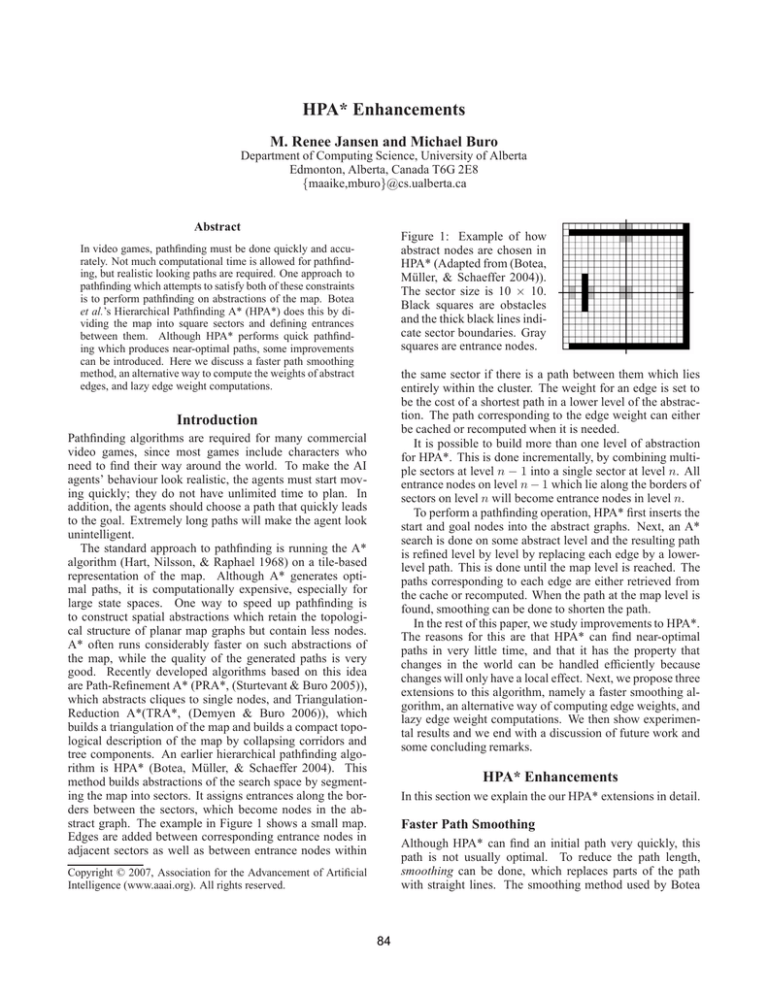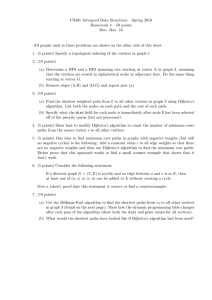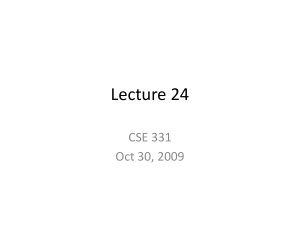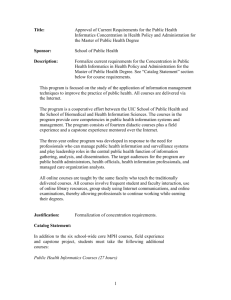
HPA* Enhancements
M. Renee Jansen and Michael Buro
Department of Computing Science, University of Alberta
Edmonton, Alberta, Canada T6G 2E8
{maaike,mburo}@cs.ualberta.ca
Abstract
Figure 1: Example of how
abstract nodes are chosen in
HPA* (Adapted from (Botea,
Müller, & Schaeffer 2004)).
The sector size is 10 × 10.
Black squares are obstacles
and the thick black lines indicate sector boundaries. Gray
squares are entrance nodes.
In video games, pathfinding must be done quickly and accurately. Not much computational time is allowed for pathfinding, but realistic looking paths are required. One approach to
pathfinding which attempts to satisfy both of these constraints
is to perform pathfinding on abstractions of the map. Botea
et al.’s Hierarchical Pathfinding A* (HPA*) does this by dividing the map into square sectors and defining entrances
between them. Although HPA* performs quick pathfinding which produces near-optimal paths, some improvements
can be introduced. Here we discuss a faster path smoothing
method, an alternative way to compute the weights of abstract
edges, and lazy edge weight computations.
the same sector if there is a path between them which lies
entirely within the cluster. The weight for an edge is set to
be the cost of a shortest path in a lower level of the abstraction. The path corresponding to the edge weight can either
be cached or recomputed when it is needed.
It is possible to build more than one level of abstraction
for HPA*. This is done incrementally, by combining multiple sectors at level n − 1 into a single sector at level n. All
entrance nodes on level n − 1 which lie along the borders of
sectors on level n will become entrance nodes in level n.
To perform a pathfinding operation, HPA* first inserts the
start and goal nodes into the abstract graphs. Next, an A*
search is done on some abstract level and the resulting path
is refined level by level by replacing each edge by a lowerlevel path. This is done until the map level is reached. The
paths corresponding to each edge are either retrieved from
the cache or recomputed. When the path at the map level is
found, smoothing can be done to shorten the path.
In the rest of this paper, we study improvements to HPA*.
The reasons for this are that HPA* can find near-optimal
paths in very little time, and that it has the property that
changes in the world can be handled efficiently because
changes will only have a local effect. Next, we propose three
extensions to this algorithm, namely a faster smoothing algorithm, an alternative way of computing edge weights, and
lazy edge weight computations. We then show experimental results and we end with a discussion of future work and
some concluding remarks.
Introduction
Pathfinding algorithms are required for many commercial
video games, since most games include characters who
need to find their way around the world. To make the AI
agents’ behaviour look realistic, the agents must start moving quickly; they do not have unlimited time to plan. In
addition, the agents should choose a path that quickly leads
to the goal. Extremely long paths will make the agent look
unintelligent.
The standard approach to pathfinding is running the A*
algorithm (Hart, Nilsson, & Raphael 1968) on a tile-based
representation of the map. Although A* generates optimal paths, it is computationally expensive, especially for
large state spaces. One way to speed up pathfinding is
to construct spatial abstractions which retain the topological structure of planar map graphs but contain less nodes.
A* often runs considerably faster on such abstractions of
the map, while the quality of the generated paths is very
good. Recently developed algorithms based on this idea
are Path-Refinement A* (PRA*, (Sturtevant & Buro 2005)),
which abstracts cliques to single nodes, and TriangulationReduction A*(TRA*, (Demyen & Buro 2006)), which
builds a triangulation of the map and builds a compact topological description of the map by collapsing corridors and
tree components. An earlier hierarchical pathfinding algorithm is HPA* (Botea, Müller, & Schaeffer 2004). This
method builds abstractions of the search space by segmenting the map into sectors. It assigns entrances along the borders between the sectors, which become nodes in the abstract graph. The example in Figure 1 shows a small map.
Edges are added between corresponding entrance nodes in
adjacent sectors as well as between entrance nodes within
HPA* Enhancements
In this section we explain the our HPA* extensions in detail.
Faster Path Smoothing
Although HPA* can find an initial path very quickly, this
path is not usually optimal. To reduce the path length,
smoothing can be done, which replaces parts of the path
with straight lines. The smoothing method used by Botea
Copyright © 2007, Association for the Advancement of Artificial
Intelligence (www.aaai.org). All rights reserved.
84
south edge entrances. In this case using Dijkstra’s algorithm leads to an asymptotic improvement over A*’s worst
case running time by a factor of 1/E, hinting at an advantage of Dijkstra’s algorithm for maps with sectors with
many entrances and long or complex paths between them.
In the best case, the number of nodes A* expands is linear
in the total path length between all entrance pairs, amounting to Θ(E 2 L log L) operations. In this situation, Dijkstra’s
algorithm will likely explore all interior nodes if the entrances are scattered along the sector perimeter, and thus
take Θ(EL2 log L) operations. Consequently, when considering large empty sectors with only a few entrances, the
entrance distance computation based on A* will be asymptotically faster.
et al. does this by shooting rays in all eight directions from
each node n on the path. When a ray reaches a node m further along the path, the original part of the path between n
and m is replaced by a straight line and the smoothing process continues with the node two positions before m on the
improved path. The resulting paths have lengths close to the
optimal length, but the computation is expensive. A straightforward way of addressing this is by placing a bounding box
around the entire path, i.e., a box spanning from the lowest
x-and y-coordinates of any node on the path to the largest
ones, and only tracing rays inside this bounding box. However, because paths may span a large portion of the map,
smoothing is slow even when we only trace rays inside this
box. Therefore, we propose placing a smaller bounding box
around the current position in the path, which will reduce
the time spent on smoothing but could potentially sacrifice
some optimality. In the experimental results section we will
show that the time reduction is significant, while the paths
are only slightly longer.
Lazy Edge Weight Computation
Because HPA*’s abstraction is based on independent sectors, changes in the map will only affect the sectors which
are local to the changes. This makes HPA* particularly suitable for use in dynamic environments.
One way to deal with these dynamic environments, as proposed by Botea et al.(Botea, Müller, & Schaeffer 2004), is to
recompute the entrances and edge weights for affected sectors when changes happen. However, in dynamic environments it is possible that the sector is changed again before
this recomputed information is needed. In such cases it is
more efficient to compute edge weights on demand, thereby
amortizing the cost of computing edge weights.
We therefore propose using a lazy approach to computing
edge weights. Instead of recomputing the weights of edges
when a sector changes, we insert edges between all pairs of
entrances in the sector and we mark them invalid. When we
perform a search, we find the weight of an edge whenever
a node adjacent to it is expanded. This is done by recursively searching in each of the levels until the map level is
reached, similar to how it would be done in the precomputation phase. Edge weights are then percolated up the abstraction until the edge at the topmost level has been assigned its
proper weight. The advantage of using this approach is that
if some edges are never needed for a search, their weights
will not be computed. In the worst case, the lazy approach
performs the same amount of work as the eager approach,
but if any edge weights are never needed, the lazy approach
will perform less computation.
Dijkstra’s Algorithm
To compute the weights of edges inside a sector, HPA* performs an A* search between each pair of entrances. We propose using Dijkstra’s single-source shortest path algorithm
for each entrance node to compute weights of all the edges
adjacent to it because the worst-case running time for A* is
worse than that for Dijkstra’s single-source shortest path, as
outlined below.
A* Running Time. Assuming square sectors, let L × L
be the sector size and E the number of entrances. Then
E ≤ 4L − 4, because there are that many
nodes located
on the edges of the sector. There are E2 pairs of entrances,
which is O(L2 ). In the worst case A* expands all L2 sector nodes in each run. For each node that is expanded, a
constant number of priority queue operations must be performed, namely removing the node from the queue, and
updating the neighbours of this node (at most 8 in an 8connected grid world). These operations can be done in time
logarithmic in the number of nodes in the queue, namely
O(log(L2 )) ⊆ O(log L). Therefore, the worst-case total
running time of A* to determine distances between each entrance pairs is O(E 2 L2 log L) ⊆ O(L4 log L).
Running Time of Dijkstra’s Algorithm. Again, let L×L
be the sector size, and E the number of entrances. The
priority queue is implemented with a binary min-heap, so
the cost of extracting the vertex with minimum weight is
O(log L2 ) ⊆ O(log L). For every vertex that is removed
from the queue, we apply at most 8 decrease-key operations. Each of these also has cost O(log L). Therefore, the
total worst-case running time for Dijkstra’s algorithm computing all distances between entrances is O(EL2 log L) ⊆
O(L3 log L).
Relationship between running times. The established
worst-case runtime bounds for both algorithms are tight.
This can be seen by considering sectors with E/2 entrances
at the north and south edges and a single zig-zag path of
length Θ(L2 ) in the sector interior connecting the north and
(a) Game map
(b) Artificial map
Figure 2: Map Samples. Only white areas are traversable.
85
Experiments
case, we build a bounding box around the entire path. In
other words, we allow the x-values to range from the smallest to the largest x-values of any node on the path, and
similar for the y-values. In the other cases we restrict the
bounding box to some small square centered at the current position. In particular, the dimension of the bounding box, centered at (x, y), was varied between (x±5, y±5)
and (x±20,y±20), i.e.,the length of the box was varied from
roughly one to four times the sector size.
Intuitively, we expect the pathfinding time to increase as
the size of the bounding box increases because longer rays
must be traced during the smoothing process. We also expect the sub-optimality to decrease as the size of the bounding box increases since the algorithm traces longer rays, increasing the chances of reaching another part of the path.
The experimental data confirms both these intuitions. Figures 3 and 4 show the results for a representative experiments on the set of game maps. A single level of abstraction
with sector size 10 was used and edge weights were computed using Dijkstra’s algorithm. The left-hand figures show
the time spent to find paths, which is significantly higher for
the case with the large bounding box, as expected. The righthand figures show the path quality. Although the algorithm
performs worse with the smaller bounding box, the difference — especially for longer paths — is only approximately
1% in the worst case. The usefulness of adjusting the size of
the bounding box lies in the fact that a balance can be struck
between shorter paths and faster pathfinding. The parameter
can be adjusted according to time or path quality requirements. For example, up to distance 100 — where smaller
bounding boxes lead to relative errors larger than 1.03 in 5%
of the cases — one could use larger bounding boxes to improve path quality and suffer only a minor runtime penalty.
The impact of the proposed improvements was evaluated by
finding paths on two sets of maps. The first set is comprised
of 116 commercial game maps: 75 maps from Bioware’s
Baldur’s Gate and 41 from Blizzard Entertainment’s Warcraft III. The maps were scaled up to 512 × 512. An example is shown in Figure 2(a). The second set consists of
80 artificial maps, also of size 512 × 512. For these maps,
square obstacles were placed on an empty map such that they
do not touch one another. The percentage of the map that is
blocked is varied from 10 to 80, and the maximum size of
an obstacle is varied from 1 to 10 (i.e., if the maximum size
is 10, the map can have obstacles of size 1, 2,...,10). An example of an artificial map is shown in Figure 2(b). For each
of these maps, random pairs of points were chosen such that
the optimal distance between them was at most 512. The
paths were divided into 128 buckets: a path is in bucket i iff
i = ⌊l/4⌋, where l is the optimal path length. For the game
maps, over 144,000 pairs of points were used for each experiment, with the number of paths in each bucket ranging
between approximately 800 (for very long paths) and 1150
(for shorter paths). For each of the 80 artificial maps, 10
paths in each bucket were used, giving a total of 102,400
pairs of points, equally distributed over the buckets.
In our implementation of HPA*, we introduce a single abstract entrance node for an entrance of at most length 5, and
two abstract entrance nodes for larger entrances. In addition, at higher levels of abstraction we combine 2×2 lowerlevel sectors into a single abstract sector. Lastly, in the eager
case all paths are cached — they do not need to be recomputed when the path is refined. We will present graphs for
two types of results: relative path length and time to find a
path. In both cases, these will be graphed against the A*, or
optimal, path length. For each of these, graphs contain percentiles, i.e., 5% of paths lie above the 95th percentile line,
and so on. All timing experiments were run on a machine
with two 1 GHz Pentium III processors and 512 MB RAM.
Dijkstra’s Algorithm
Smoothing
To compare the effect of using Dijkstra’s algorithm versus
using A* to compute edge weights, we performed experiments on both sets of maps for three different sector sizes
and between one and three levels of abstraction.
To evaluate the proposed smoothing method, we performed
experiments with varying sizes of bounding boxes. In one
Game Maps. The first set of experiments was performed
on the game maps. Tables 1 and 2 show the time spent on
0.07
99%
95%
50%
5%
0.4
0.25
0.2
0.15
HPA* length / A* length
Time (s)
0.3
Time (s)
1.25
0.05
0.35
Max
99.5%
98%
95%
1.3
99%
95%
50%
5%
0.06
0.04
0.03
0.02
Max
99.5%
98%
95%
1.3
1.25
HPA* length / A* length
0.5
0.45
1.2
1.15
1.1
1.2
1.15
1.1
0.1
1.05
1.05
0.01
0.05
0
0
100
200
300
A* Path Length
400
(a) Large bounding box
500
0
0
100
200
300
A* Path Length
400
1
0
500
100
200
300
400
A* Path Length
(b) Bounding box ranging from
(x-5,y-5) to (x+5,y+5)
(a) Large bounding box
Figure 3: Time spent on pathfinding when smoothing with
different bounding box sizes
500
1
0
100
200
300
A* Path Length
400
500
(b) Bounding box ranging from
(x-5,y-5) to (x+5,y+5)
Figure 4: Path quality when smoothing with different
bounding box sizes
86
Table 5: HPA* using Dijkstra’s algorithm with sector size
10 and 1 level of abstraction, no smoothing.
Table 1: HPA* using A* to compute edge weights. No
smoothing. Game maps. Build indicates the total computation time in seconds to build the HPA* representation for
all 114 game maps. Path indicates the total time to find all
paths on all maps which includes adding the start and goal
nodes to the abstraction graph. The shortest pathfinding time
is emphasized.
Lvl. Build
1
2
3
Sector Size 5
Path
Total
Build
Sector Size 10
Path
Total
Build
Eager
Lazy
1
2
3
Build
Sector Size 20
Path
Total
Table 3: HPA* using A* to compute edge weights. No
smoothing. Artificial maps.
1
2
3
Sector Size 5
Path
Total
Build
Sector Size 10
Path
Total
Build
Sector Size 20
Path
Total
722.47 5343.01 6065.49 1308.43 2791.80 4100.24 2403.61 2126.79 4530.40
1213.79 3061.99 4275.78 2231.80 1926.67 4158.47 4053.77 2901.60 6955.38
2985.08 2905.47 5890.55 5230.43 3470.52 8700.96 9035.56 8337.21 17372.78
Conclusion and Future Work
In this paper we have presented three extensions to HPA*.
We have shown that smoothing can be sped up at a cost of
slightly longer paths. We have also shown that using Dijkstra’s algorithm instead of A* can be beneficial for computing the edge weights. Lastly, we have proposed a novel
approach for using HPA* in dynamic environments. Instead
of pre-computing edge weights it may be beneficial to compute them on demand. Preliminary results are promising,
but further investigation is needed to accurately assess the
merits of this approach in dynamic environments.
Looking beyond fixed game maps for which pathfinding
data in form of abstraction graphs and edge weights can be
precomputed, interesting questions are how HPA*, PRA*,
and TRA* can be extended to work efficiently in large dynamic environments featuring many moving objects, changing topologies, and incremental terrain discovery.
Table 4: HPA* using Dijkstra’s algorithm to compute edge
weights. No smoothing. Artificial maps.
Lvl. Build
1
2
3
Sector Size 5
Path
Total
Build
Sector Size 10
Path
Total
Build
1840.23
1759.60
As an investigation into the benefits of performing lazy
weight computation as opposed to precomputing edge
weights, experiments were run with Dijkstra’s algorithm, a
single level of abstraction, sector size 10, and no smoothing. Table 5 shows some cumulative results for these experiments. First of all, it is clear that the initial time to
build the abstraction is much smaller when paths are not precomputed, as expected. The fact that the total time for the
lazy approach is smaller than the total time for the eager approach indicates that for our experiments, the edge weights
are never computed for some sectors. It seems likely, for example, that sectors near the borders of a map are less likely
to be used. It is unclear whether this is often the case in
practice, but if it is, this method could be particularly useful
since the speedup in the building of the map is significant.
675.61 3163.10 3838.71 743.40 1096.83 1840.23 1008.87 1196.24 2205.11
785.63 2120.97 2906.60 797.36 1121.18 1918.54 1025.68 1235.57 2261.25
899.77 1472.71 2372.48 878.66 1142.58 2021.24 1057.81 1364.04 2421.85
Lvl. Build
Total(s)
Lazy Edge Weight Computation
Table 2: HPA* using Dijkstra’s algorithm to compute edge
weights. No smoothing. Game maps.
Sector Size 10
Build Path
Total
Time to find paths
Total(s) Avg(ms)
1096.83
7.61
1409.14
9.78
precomputes weights almost twice as fast as A*.
Sector Size 20
Path
Total
597.48 3118.37 3715.85 651.45 1057.02 1708.47 903.12 1219.82 2122.94
762.90 2093.52 2856.41 832.87 1213.56 2046.43 960.75 1461.38 2422.12
1027.77 1659.27 2687.04 1395.55 2273.28 3668.83 1140.23 2804.71 3444.94
Sector Size 5
Lvl. Build Path
Total
Time to build (s)
Total(s) Avg(s)
743.40
6.41
350.46
3.02
Sector Size 20
Path
Total
672.22 5501.56 6173.78 954.87 2857.86 3812.73 1312.89 1879.64 3192.52
954.59 2109.24 4063.83 1248.94 1670.43 2919.37 1735.63 1632.04 3367.66
1803.92 2490.78 4294.70 2228.62 1713.25 3941.87 3202.39 2465.34 5667.73
building the abstractions and finding the paths for A* and
Dijkstra’s algorithm, respectively. Both algorithms perform
fastest with a single level of abstraction and sector size 10,
but A* performs a bit better. In fact, A* performs slightly
better for any sector size with a single level of abstraction,
but as the number of abstract levels increases, Dijkstra performs better, at least for larger cluster sizes. This can be explained by the fact that A* needs to expand larger numbers
of nodes when the (abstract) sectors are larger.
References
Botea, A.; Müller, M.; and Schaeffer, J. 2004. Near optimal
hierarchical path-finding. J. of Game Develop. 1(1):7–28.
Demyen, D., and Buro, M. 2006. Efficient triangulationbased pathfinding. In Proceedings of AAAI, 942–947.
Hart, P.; Nilsson, N.; and Raphael, B. 1968. A formal basis for the heuristic determination of minimum cost paths.
IEEE Trans. on Systems Science and Cybern. 4:100–107.
Sturtevant, N., and Buro, M. 2005. Partial pathfinding
using map abstraction and refinement. In Proceedings of
AAAI, 47–52.
Artificial Maps. The results for the second set of experiments, which use the artificial maps, are shown in Tables
3 and 4. The maps were designed to increase the number
of entrances in any sector. The expectation was that this
would increase the amount of work done by A* relative to
Dijkstra’s algorithm, and the experimental results confirm
that this is the case. In particular, the A* approach spends
more time building the abstractions except in the case of a
single level of abstraction with cluster size 5. Dijkstra’s algorithm is slightly slower for pathfinding in some cases, but
14% better overall in the best setting (sector size 10 and two
levels of abstraction). In this case Dijkstra’s algorithm also
87



